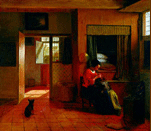










8.
Virgin or Vixen? Considering Models
of Female Autonomy in Early Modern Europe
Organizers:
Description:
Scholars of early modern Europe have increasingly embraced the notion that individual identity could be constructed to suit a specific social situation. While much has been written on social perception and the ways in which the public self could be formed and maintained, research in this area has focused almost exclusively on men. Yet, there is a strong female component to self-fashioning that has yet to be examined. The options available for women to create their own public identity in a male dominated world merits further investigation.
In the workshop, we will examine and discuss those exemplars available to women and the extent to which the early modern woman constructed an ideal persona. How did self-fashioning assist early modern women operating within a social, political, and religious environment controlled primarily by men? To facilitate this discussion, both Hurlburt and de Maria will present short slide-based introductions to competing modes of public identity. Hurlburt's overview will concentrate on the implementation of chastity and sexuality as strategies for survival and influence in early modern history. De Maria will present an equally brief outline of alternative models promoted in the visual arts. We will then shift our focus to a discussion of the myriad paradigms of emulation available to the early modern woman. Potential models may be found not only in the powerful women of classical antiquity, but also in fictional women found in art, music, and literature. As such, this workshop will attract participants from a variety of disciplines.
The excerpt from Stephen Greenblatt's Renaissance Self-Fashioning provides an excellent, albeit brief, introduction to the concept of early modern identity and the ways in which the public self could be manipulated to one's advantage. The remaining readings address notions of virginity, sexual freedom, and personal ornamentation as markers of public identity. It is our hope that these primary sources -- all written by women -- will serve as the as the starting point for what we hope will be a fruitful discussion of the options or lack thereof available to women in constructing their public selves and how these personae could be used to influence the accepted social, political, and even religious boundaries of early modern Europe.
|
|
|
||||||
|
|
 |
 |
|
||||
 |
|
 |
|
||||
|
|
|
||||||
|
|
|
||||||
 |
|
||||||
|
|
|
||||||
| |
|
||||||
 |
|
||||||
 |
|
||||||
 |
|
||||||
 |
|
||||||
|
|
|
||||||
|
|
 |
|
|
||||
 |
|
||||||
|
|
|
|
|
|
|
|
|